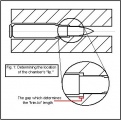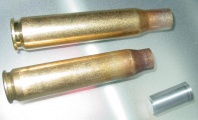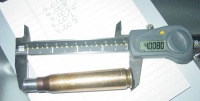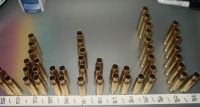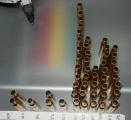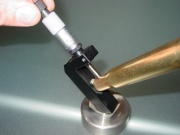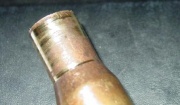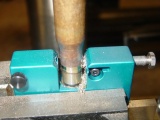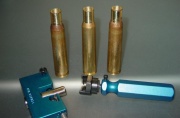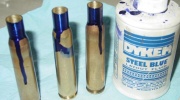BMG match ammo preparation
- You probably want to make sure you have a good understanding of standard reloading before you go digging around too deeply here. It's also a good idea to check out the page on reloading the .50 BMG as well. Trust us on that one.
"Match grade" is ammunition that is going to be the best you can make it. By "best," we mean the most accurate for one, specific rifle. The ammunition gets customized to a specific rifle. It might not even chamber in another rifle and, even if it did, shouldn't be used there anyway. We'll try to point out which steps might make custom ammunition dangerous in a rifle other than the one that it was customized for.
While this page uses .50 BMG as the subject cartridge, match grade ammo can be made for just about any caliber or firearm and many of the procedures described here can easily be adapted for other cartridges.
[edit] Determining trim-to length
| Here's a step that could get the amateur in trouble — if you don't completely understand this step, don't do it! You can make good ammo using the printed specifications found in your loading manuals for trim-to length. Trim-to length is some length that allows room for case stretch when fired, such that the case mouth doesn't stretch into contact with the lip in the chamber. If the case is too long it will contact the lip and crimp down on the bullet, which can result in excessive (dangerous) pressures. |
To find your custom "trim-to" length, the first step is figuring out the exact location of the lip (figure 1):
There are a couple of ways to measure this, with a commercial gauge or using 'Varmint Al's' method.[1] I don't know of anyone that makes a commercial gauge for the .50BMG, but if you, or a friend, have a lathe you can make one pretty easily. Make it from 12L14 or similar soft steel so it won't damage your chamber. The one in figure 2 is made from aluminum.
Like any other critical measurement, you should take the measurement four or five times to make sure that you're getting a repeatable measurement. A couple of thousandths (0.002" or so) is repeatable. Once chamber depth is known, you can adjust trim-to length to be sufficiently shorter, without overdoing it. I like to err on the side of safety, so I'll trim 0.010" shorter than my chamber length. If you really want to get all you can, trim a cartridge to nominal length, load and fire it, and measure it after firing. The difference is the amount of permanent stretch. Assume twice that amount as the temporary stretch that occurs (remember, the brass will stretch and then "snap back" during firing) and add a couple thousandths (.002"), just to be safe.
[edit] A brief word about loading presses
There is some small (ok, maybe not-so-small) debate regarding which is better: a turret press or a single-stage press. There are advantages and disadvantages to both, and some other alternatives as well.
Single stage presses are very solid and if the die holder plate is parallel to the shell holder and rigid, it will remain parallel. On a turret press, some "slop" is needed to allow the turret to rotate. This can be somewhat mitigated by proper setup procedure. (eg., run the die down to the shell holder, then snug the lock ring - this should (there's that S word...) serve to align the die (under pressure) to the shell holder. This will rectify some slop, but not a lot.)
Given that, you might think that a single-stage press is the hands-down winner for accuracy - and there are certainly plenty that would agree with you. Or disagree. See if you can make a game of picking them out.
The accuracy advantage of a turret press is that the dies are always set up and so should (that S word again...) have absolutely zero variation from one loading session to the next. An alternative, then, is to have multiple single-stage presses. This is mostly a matter of space, as three or four single stage presses turn out to be cheaper than a turret press in most calibers.
Another alternative is the use of hand dies sometimes called arbor press dies. Hand dies are still a scarce item for .50 BMG and other big rounds, but M2 Precision is offering an FL sizer, and hopefully will produce a seater soon. LE Wilson is rumored to make 'anything you want' IF you provide the reamer. In case a web search turns something up, I strongly recommend against the flake at Warner Tool Co. - I ordered a custom die set from him over two years ago, thus far without results...
Hand dies are probably the ultimate for accuracy, because the only press parameter that matters is whether it can supply sufficient force. The die takes care of all alignment issues. The disadvantages are that hand tools are expensive ... and slow.
Alright! Let's get down to brass tacks, ...er... cases, as it where.
[edit] Cartridge selection & sorting
If you're going to spend a lot of time and energy trying to make the best ammunition, you'd better start with good cases. Silk purses, sows ears, and all that. As I write, the favored case in competition is IMI (Israeli Military Industries) The lot I have has a headstamp of "IMI 01 ⊕" where 01 indicates that it was born sometime in 2001 and ⊕ is the NATO mark. My personal next choice would be Winchester commercial, usually headstamped "CAL 50". If I were going to try to make match ammo from military brass I would start with a 10-12 brass for every 5 that I wanted to end up with, and cull mercilessly. That said, let the culling begin...
Step one is to visually sort the brass - look for any kind of dings, defects, etc. Lightly dinged case mouths will be ironed out by the sizing die, but dented shoulders, gouges, voids, etc. are cause to discard. If you are truly after the most accurate ammunition you can make, you will err on the side of discarding anything questionable. One of the perks of buying quality up front, is you will very likely not discard much.
Note on sorting by weight: Most benchrest shooters, and other accuracy-minded reloaders, will sort their brass by weight. Most manuals have this as the first step. My experience is that sorting by weight is most accurate and effective after all of the trimming etc. is done to the case. Why throw away cases that have a big flash-hole burr when we're going to trim that away anyway? Once the cases are trimmed and have uniformed primer pockets and flash holes, then weighing will go a long way toward pointing out differences that still exist.
All of my IMI brass survived this first round of culling, though there was one that had enough of a ding on the mouth that it may be culled later, if sizing and trimming don't iron that out.
[edit] Initial sizing
Given that you're starting out with brand new brass, some folks like to size it, others just load it as is (new brass is usually suitably sized for loading when acquired). I fall into the former camp, so I will full-length size all the brass with which I start just so I am starting from a known point. There is no difference to this step from the standard sizing except that I remove the decapping stem from the FL sizing die. It's fairly well documented that much case distortion is caused by expander balls. For this reason it is preferable to use a mandrel, but I do not know of a currently manufactured mandrel for .50 shooters. (I'm checking on that...)
[edit] Trimming to length
Trimming is the same as with plinker ammo, except that we now have a potentially longer trim-to length, as previously discussed. Depending on your chamber, you may have brass which is already shorter than required. Consistency is the key to precision, so in this case I adjust the trimmer to just uniform the ends and then trim the batch. At this point I note that I can no longer tell which brass had the ding in the case mouth - an indication that there was nothing wrong with it.
[edit] Uniforming primer pockets and flash holes
The trusty K&M tool comes out and earns it's keep some more. Same as before. The goal is to make a nice, square bottom to the primer pocket, so that every primer sits exactly as deep as every other. At this time I also uniform the flash holes. K&M makes a handy flash-hole uniformer, I chuck it in a cordless drill and go to town. Fig. 5 shows the tools that do the job: top is the flash hole uniformer, bottom is primer pocket uniformer. Both of these are made by K&M. (I wish the flash hole uniformer had a steel, rather than aluminum body, but that's just me...).
With the flash holes and primer pockets uniformed, and every case the same length, it's now fair to sort by weight. I wash the brass first to get rid of leftover lube from sizing, as well as any brash chips left from the various metal cutting operations.
[edit] Sorting by weight
Sorting by weight is a stop-gap technique used to sort cases when all other methods have been exhausted. The purpose of match preparation is to make each case as identical as possible, and as uniform as possible. (i.e. we don't want identically defective cases, we want identically perfect cases...) We've trimmed the cases all to the same length, we've profiled the primer pockets and flash holes. There's very little we can do to measure differences between cases anymore, and even less we can do to eliminate the differences. So now we sort by weight.
In sorting, we want to determine the average weight of a case, and see how much variation there is amongst the lot. We will discard anything that falls very far from the 'average' as the difference would seemingly indicate some manner of defect, or at least difference. For the statistically astute, we want the mode (not necessarily the mean) and maybe +/- 2 standard deviations, if the standard deviations are sufficiently tight. For those who hate statistics (98.32% of you...) lay your cases out as shown, below, in 'bins'. I determine 'bins' by progressively shrinking measures. Here I started by weighing each brass and sorting to the nearest 0.2grns (fig. 6). That yielded no useful pattern, so I increased the 'bin' size to 0.5 grn (fig. 7). That was marginally better, but still not enough to separate the wheat from the chaff. Finally, I sorted by two-grain increments (fig. 8) and that yielded useful information.
As you can see from the pictures, the six pieces to the left are notably lighter than the rest of the brass, indicating somewhat significant differences. They are culled for this reason. (In this case, I culled them by marking them with red Sharpie marker on their base. They will not be used in a match, but for curiosity, I will test them against their brethren in practice. (I encourage you to do this - always test your 'rejects' against your 'perfect' ammo to verify that you are, indeed making improvements in your loading practices.)
Another note: the more brass you have to sort, the more meaningful your 'statistics' will turn out to be.
[edit] Neck measuring
Before I turn, I measure my case necks to check thickness and uniformity. By measuring each case neck at four locations (think 3 o'clock, 6 o'clock, 9 o'clock, and 12 o'clock) I can tell how much variation there is in the case thickness. I can also tell what the minimum thickness is. To get my necks at perfectly even wall thickness, and identical throughout the batch, each neck would need to be turned down to the thickness of that thinnest part of the thinnest neck. In practice, I'll just turn until the thicknesses are close. We'll discuss the setup momentarily. For the .50, neck thickness can be measured with a caliper, micrometer, or specialized neck-thickness measuring micrometer. I'll use the latter, because I have one, but if I were only loading .50, I'd just use calipers.
[edit] Neck turning
There are a number of reasons to neck-turn your brass. Some benchrest rifles are cut with extra-tight chambers and require neck turned cases, just to chamber - I'm going to assume that if you have such a critter, you know all about it. For those shooting 'factory' rifles, there are still some advantages to be had. Neck turning uniforms the wall thickness. A uniform wall thickness results in more uniform release tension, the case lets go of the bullet evenly, directly contributing to accuracy. Uneven tension while seating bullets can cause the bullet to cant, increasing runout. Finally uniform necks present a uniform amount of tension for each and every case, minimizing one more potential inconsistency.
To determine how much to neck turn, I will take four or five cases from the lot to be prepped and set my neck turning jig to just scrape some brass off. I'll turn all five and then examine them. What I'm looking for is a depth that cuts about 75% of the way around the 'average' shell. It may cut all the way around one, and barely cut at all on another, at the extremes, but for three of the five, I want 75%. Now on this first pass it's unlikely that I got there (if I did, I was rushing things...) so I'll adjust the cutter in ever-so-slightly and try again. I repeat this procedure until I get the depth I want. (~75% on most of the cases.) If you use the K&M, or another trimmer that allows you to measure your turned thickness, you can just adjust right down to your desired thickness. (Probably .001" more than the thinnest measurement from before, although maybe the same as that measurement, or a thou under, there's no magic here - go with what seems right to you, and experiment. Just remember that you can always take more off, you can't usually put any back...
I've motorized my turning setup, by using my drill press. It works just as well, if not quite as conveniently, by hand. Note that my drill press has a DC motor and can be turned very slowly - I go probably 30 rpm. Note also that the trimmer isn't actually clamped in the photos, it's 'floating' in the clamp jaws - this allows it to align naturally to the shell (fig. 10).
[edit] Priming
I prime the cases same as in the standard reloading section, using the M2 Priming system. There are a lot of similar tools on the market now.
Some shooters sort their primers by weight, using only primers that weigh whatever they determine to be the nominal weight. I don't bother with it. A note on what's about to happen At this point we're still prepping the brass, and I consider the first shot from each case to be part of that prep procedure. With 50 cases to fire before I start labeling any of this ammunition as 'match', there's ample opportunity to do some experimenting or load development. (Incidentally, if 'match prep' reloading has seemed surprisingly non-magical to you, that's because the real magic is in load development.) We'll discuss that later...
[edit] Record keeping
Record keeping is as important to accuracy as any other step. Show me someone who consistently loads quality ammunition for their rifles, and I'll show you a good record keeper. Record keeping lets you put together the pieces of the puzzle as you collect data. Every reloader I know uses a different system, but I'd suggest keeping at least the following information:
- Brass Headstamp (lot # if known)
- Powder, lot #, and charge weight
- Trim-to length
- Neck bushing used (you'll probably play with varying tension later...)
- Primer used
- Bullet, weight, lot #
- Cartridge OAL, and how measured
- How OAL was determined: are you trying to be 0.010" off the lands?
- Maximum runout
- Firing data: which gun, what conditions, what results
Lots of amateurs forget to come back and note firing data, some just pick one load they liked and forget about the others. None of those folks are on their way to consistently producing match ammunition. Keep a record of *everything*.
[edit] Charging
"Match" ammunition should be as good as you can make it, and that means weighing out each and every powder charge. This can be a pain with the BMG, because we're talking about a lot of powder. I set my powder thrower to throw as close as possible, and trickle up to the correct amount. Hint: Don't set your measure to throw 'under' or you'll be trickling 'til you're blue in the face. Set it to throw exactly what you want, you can always 'recycle' the throws that are a little heavy, and you'll have very little trickling to bring the others up to weight. If you're experimenting with different charges a small scoop is handy for adding or subtracting from the pile.
Many shooters will buy a 'lifetime supply' of a powder if they like it, just to get the powder all from the same lot. For a match barrel in a small caliber this might be 8-16#, but for the .50 it could get to be a very large quantity...
[edit] Bullet-seating
Seating the bullet in the case straight is extremely important, it's also almost entirely dependent on the seating die. Standard seating dies have a pusher which roughly matches the bullet tip ogive, and the bullet is forced into the case as the case is rammed into the die, with the bullet against the stationary pusher. Typically in such a case, the bullet leans to one side and is straightened out by the neck of the case as the bullet is seated. This isn't really straight, however, and a great deal of runout occurs. Precision (often called in-line) seating dies support the case and case neck and attempt to guide the bullet into place. These dies usually have a spring loaded sleeve that allows all of the components to be grasped and held in place before seating pressure is applied. Cartridge Overall length (abbreviated COAL, or OAL) is the length of the loaded cartridge. It's also the most convenient way to express how deeply the bullet has been seated into the case. The effects of seating depth are surprising. Because seating depth determines how far the bullet 'jumps' before encountering resistance, in the form of rifling, it plays a key role in determining both pressure and velocity. Too much 'jump' can adversely affect accuracy. There are varied ideas of how one should pick an OAL, but they all revolve around the location of the lands that will first touch the bullet.
In practice there are three seating depth considerations:
- 1. Finding the maximum OAL your rifle can take
- 2. Measuring your cartridges repeatably
- 3. Determining your optimal COAL
I'll also mention what I call "magazine OAL". In many rifles, the magazine will limit the maximum OAL you can use. If you have a magazine equipped rifle, and want to use your magazine, make sure you determine what maximum OAL your magazine will accommodate. (Many shooters will ignore the magazine for match ammunition and single load their rifles. Single loading is, in fact, required in a good many competitions.) The first two steps are the easy ones. To measure maximum OAL, I use a Stoney Point OAL gauge. The gauge uses a modified cartridge case (I think I got my case from AAA Ammo). If you don't have a Stoney Point gauge, and are at all handy, I'd suggest making one. There's nothing special to commend the commercial unit, and it uses a damnably fine thread for which I cannot locate a tap. (This just in: The tap size is 5/16"-36, knowing that, you can readily order taps from MSC, J&L, KBC, etc.) Construction details will be nearly self-evident from the photos and description.
Figure 14 is the Stoney Point gauge, the modified cartridge and three bullets to be measured - remember OAL will vary with your bullet types. In fact, the Harlow Solid is so pointed that in my rifle there was no useful maximum OAL, you can't seat that particular bullet out too far (for MY rifle - your mileage may vary!).To use the gauge, the modified cartridge (the modification involves drilling through the base, tapping it to thread onto the gauge, and leaving enough of a hole for the gauge push rod to extend through.) is attached to the gauge, and a bullet, of the type to be used is set into the case neck. The case is pushed into the chamber of the rifle, and the push rod is used to extend the bullet forward until it will no longer advance with light pressure. The push rod is locked in place and the device retracted. Often the bullet remains seated in the chamber and must be knocked loose to be retrieved. This done, the bullet is replaced in the cartridge, where it is held to the previously-determined length by the still-locked pushrod. The length is then measured. There are several sources of error possible in this measurement, so I suggest repeating the measurement four or five times until you are convinced that you are making good, repeatable, measurements. Log this number, it is the Maximum OAL to which you may load the particular type of bullet you used in the measurement. If you switch bullets, or wish to experiment with another, you'll need to measure OAL again. Loading to your Max OAL places the bullet right up against the lands, where a number of shooters insist it belongs. It will also spike your pressure relative to a shorter OAL, so back off the powder charge and work back up when seating against the lands.
The lands erode as the barrel wears, so repeating this measurement a few hundred rounds from now will likely result in a longer OAL. (If it's shorter, you need to clean your rifle better...) This is also why you want to log how you determined OAL for your load - if you want the bullet .010" off the lands, you may have to seat them a little longer as time goes on.
The next step is measuring the COAL repeatably. This task is greatly aided by some type of 'comparator'. A comparator gives a relative measurement. That is to say, the measured number is useless to you, or anyone else if you don't have the comparator. It is only good for adjusting a cartridge relative to your measurement. For this reason I suggest loading a dummy round and measuring it with and without your comparator, then writing the measurements on the dummy case itself. With that information you should be able to figure out where you are if you should lose your comparator. One of the obstacles to measuring OAL reliably is the degree to which the tips of some bullets can get mashed up. This is not much of a problem for the .50BMG, so direct measurement may suffice. A good test is to measure the length of several bullets. If the bullets all measure identically, you should be in good shape. If the bullet length varies, you can expect at least that much variation in your OAL without a comparator. (If they vary, you might ask yourself why you'd consider putting them in match ammo...)
There are several types of comparators available, the 'nut' type shown upper left (fig. 15) resulted in a measurement too long for 6" calipers, so the measurement in this case is direct.The final step is determining your optimal OAL. That can only be done from experience and testing. Some folks set everything against the lands. I start at nominal OAL (from the loadbook) and inch forward about .010" at a time. Once I find the length that my rifle likes, I'll back off .010" and creep in by .002" increments. I want the *exact* favorite length. I'll be writing on load development later, so I'll leave it at that for now.
While we're on the subject of bullets, it should be noted that many shooters sort their bullets by all kinds of criteria, and you can too! Try:
- Weight - the obvious criteria
- Concentricity - you'll need a concentricity gauge
- Center of mass concentricity - this is a bit esoteric, and requires special equipment, but it's possible to determine whether the bullets center of gravity is on-axis or not.
[edit] Fire forming
Piece-o-cake, and a fun step. Fire forming simply involves firing the loaded cartridges in the rifle for which we're building them. Not everyone agrees with this step, but ideally speaking you want a cartridge that 'just' fits your chamber. Using brass that has been fired in your rifle is the closest you can get. In practice, the fireformed brass is still undersize (it has to be to go in easily) and grows a little with each firing. Eventually it will become difficult to chamber, and you'll have to do some light body sizing to chamber it again. In smaller calibers, case micrometers exist that will allow you to measure and dimension your brass at this stage. I know of no such device for .50 BMG, but much the same can be accomplished by setting aside a case or two at this point. These cases can be used for setting up your FL die to size minimally when your fired cases need it.
[edit] Cleaning and Re-sorting
The first shots have been fired, it's time to clean the cases for reloading. There are no special steps to cleaning, just tumble and go. I sort the brass again at this point. (See the Standard Reloading page for detailed information about sorting.) Sorting is an on-going process, but is especially important here, as the first firing may show up any defect in the case that were not caught by previous screening steps. (Especially if you didn't sort by weight.)
[edit] Neck sizing
Ahhh, the moment you've all been waiting for. Well, maybe not all of you, but when I mention match reloading to a lot of folks I immediately get neck-sizing questions. First, there is nothing mysterious or tricky about neck sizing. Neck sizing allows two things:
- Neck sizing allows you to preserve the tighter-than-average body dimensions of brass fired in your chamber.
- Neck sizing gives you more control over the amount of tension with which the bullet is held.
Preserving your body dimensions allows for greater consistency, and doesn't require much explanation. Controlling the tension that holds the bullet warrants some discussion. First, we can control the tension by picking different size bushings to size the neck down farther (more tension) or less (less tension). This is an important point, because it points out a critical fact: the size of your neck bushing is somewhat arbitrary! You need a bushing that will size your neck down some, just to make sure that each case grasps the bullet with equal tension. (If your bushing were too large, it might size your most-expanded cases, but not others. Such a situation would result in non-uniform neck tension, which results in non-uniform velocities, which result in non-uniform groups...!) The *correct* amount of sizing will vary with your load and your rifle, so ideally you would have a broad array of bushings with which to experiment.
[edit] Picking your neck bushing
Lacking unlimited finances, measure your neck wall thickness (As a sanity check, my IMI brass is about 0.0215" before trimming.) Double this number (There are two neck wall thicknesses in a diameter.) and add the bullet diameter. (0.510" unless you're using something exotic) This number (0.553" in the example) is approximately the neck diameter you should measure once you have a bullet seated. Any number smaller than this is appropriate for neck sizing. For .50, I'd start .005" smaller than this, so a .548 bushing. If you can swing it, buy some bigger and smaller bushings with which to experiment. (You needn't buy them all at once. Once you start load development you'll want to change only one parameter at a time, so you will want to do plenty of testing before you switch bushing sizes.)
[edit] Setting up your neck sizer
The neck sizing die setup is fairly straightforward. Run the press ram to the top of its stroke, then screw the die down to meet it. When the two touch snug up the die lock ring. (Placing dies in this manner is good practice, as it helps align the die to the shell holder.)
That much is like any sizing die, but the neck sizer has an extra adjustment to adjust how far down the neck the sizing bushing travels (fig. 17).
If you've replaced or removed the bushing, you had to unscrew this knob to get it out. Tightening the bushing down increases how far down the neck is sized. Being a visually oriented person, I like to see this, so I dye up some case necks (fig. 18) when I'm setting up, using layout fluid. (If you don't have layout fluid, Sharpie marker works pretty well too.) Note that this is only a setup step, I don't do this to every brass.
With the necks dyed, it's easy to see how far down the neck bushing is traveling. In fig. 19, the left neck is barely being sized, the middle neck a little less than half way and the right neck is being sized completely.
Once you are sizing as much of the neck as you want to (not everyone sizes the full neck) lock the bushing adjust ring in place and you are good to go. (Once the lock ring is locked on, I pull the bushing and wipe out any layout fluid that rubbed off in it. (Acetone works well, but is bad for you...)
[edit] Trimming to length
The biggest argument I can make to buy the best (most convenient) case trimmer is to allow you conveniently trim every brass, every time it is fired. Varied wall thickness will cause variations in brass "growth". I like to remove these variations after each firing. For those still reeling from the miserable experience that trimming a bunch of length off of a bunch of brass, rest assured it is much easier now that you are trimming .001" or less. Most trimmers can be hooked to a cordless screwdriver, or drill press to further ease the process. The Giraud trimmer is so easy it's not fair...
[edit] Repriming
Another step that's easier the second time, I run the primer pocket uniformer through all the primer pockets again, this scrapes out the carbon and whatnot, and may trim a little more brass that has "flowed" during firing. Some folks don't like to cut the pocket more than once, and go after the primer pockets with a brush to clean out carbon buildup. I know of no commercial brush made for this purpose (as there are for standard rifle sizes) but sufficiently close sizes are available at your local hardware store where they stock Dremel/Foredom/die grinder bits.
[edit] Charging
If you're done with load development, just weigh each charge as exactly as you care to. If you are performing load development take extreme care to keep your differently charged cases separate from one another, and clearly identified. If you mis-identify the charges you're testing, all your work is in vain!
[edit] Bullet seating
There is little more to add to bullet seating. Careful measurement and adjusting of each desired setting will contribute to greater reproduce-ability down the road.
[edit] Measuring and sorting by runout
With all this "match" ammo loaded, there's nothing else that can be done, right? Wrong! If you're super-serious, you can further 'cherry pick' your ammo. Check the cartridge OAL on each round - seperate any that are shorter or longer than the rest. (Also, try to figure out how you did that - it shouldn't happen.) Gage the ammunition if you have a gage available. Finally, measure the runout on each round. This requires a concentricity gauge. Measure runout of the case body, near the shoulder and runout of the seated bullet, near the cartridge neck. You will have to establish what you want to accept and what you don't. If only one cartridge "passes", you need to re-examine your standards, your equipment, and/or your loading practices. The goal is to take the best ammunition you can manufacture, and have enough of it to participate in a match, or perform whatever shooting feat you have in mind. (Don't forget to have extra for spotters, alibi shots, etc.)
[edit] A note on adjusting out runout
Note: All of the following is speculation on my part. I do not own, nor have I used, any of these adjusters. What follows is my opinion, for what it's worth. If you have a differing opinion, and can articulate your reasoning, I will be happy to post your thoughts, with or without attribution, at your discretion.
I see in the magazines now that there are tools for adjusting out runout. I'm very skeptical about the efficacy of these tools. The right way to make match ammo is to build it right the first time. If you use some specialty vise to bush a lopsided bullet back into concentricity, something must move:
- The bullet must 'slip' in the neck, resulting in a different cartridge OAL, and possible marring of the bullet surface. Marring may not be the issue it was once thought to be, but OAL is critical.
- The neck must bend to hold the bullet straight. This is just a transfer of the non-concentricity. If the brass is non-concentric, but the bullet is there may be some improvement, but the round will never be as good as a concentrically-seated bullet in a concentric case.
- Some other part of the cartridge must bend. Same result as above.
Finally, this is the wrong 'attitude' to take for creating match ammo. Match ammo is not about trying to salvage bad ammo (use that stuff for plinking), it is about picking the very best, in hopes of getting the very best possible results.
[edit] Notes
- Original web source from: "Shooting the .50BMG" by W.R.
- ↑ The poor man's gauge:

You can make a "Poor Man's" gauge to measure how long your chamber is. You will have to sacrifice a piece of brass. Take a FL-sized piece of brass and drill out the primer pocket with a 1/4" drill. This is so you will later be able to push the bullet out if you need to. Cut half of the neck off with a hacksaw. Make a careful cut and save the piece you saw off. De-burr and chamfer the new neck opening of the piece of brass and the tiny piece you cut off. Slit the piece you cut off so it will slide on a bullet with a few pounds of force. Seat a bullet into the case and chamber the round to make sure the bullet is not seated farther by the lands. Remove the cartridge case with the seated bullet and slip the tiny brass split ring over the bullet and chamber it again. Your chamber will slide the piece of brass ring back down the bullet when it hits the end of the chamber. Carefully remove the cartridge case and measure. Measure the length from the base of the cartridge case to the top of the tiny ring. That is your actual chamber length. You might want to do this a couple of times to be sure of the measurement. 
— Varmint Al's webpage
